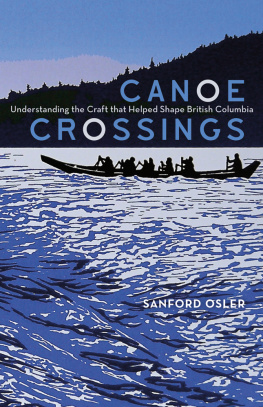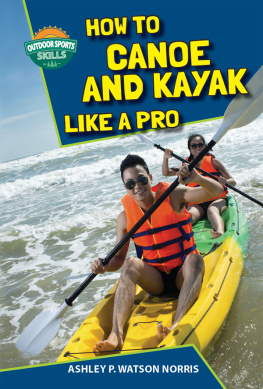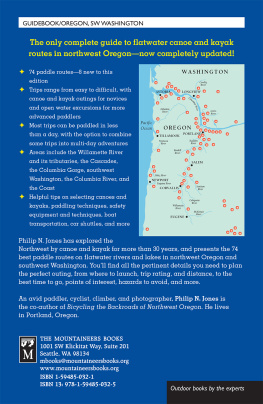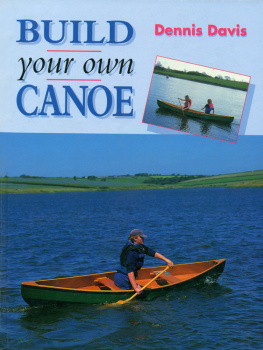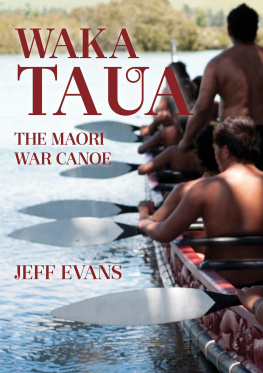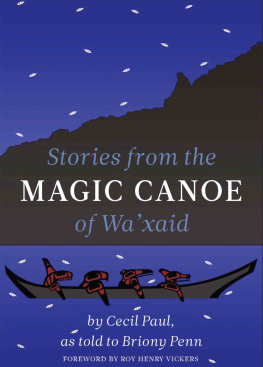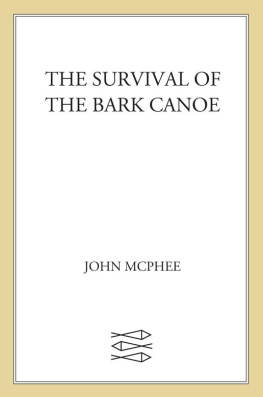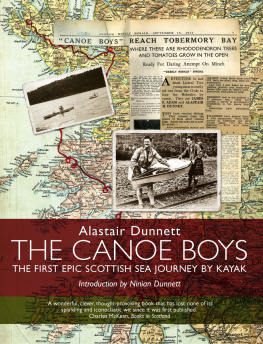chapter one 
THE BIRCHBARK CAN O E
IVE had an interest in canoes for as long as I can remember. One of the first bedtime stories I recall was Holling C. Hollings Paddle-to-the-Sea, a tale of a young First Nations boy who carves a small canoe modelled on his fathers birchbark one and launches it in the waters north of Lake Superior. The canoe slowly makes its way through the Great Lakes, surviving various close calls with forest fires, sawmills, and waterfalls, and eventually makes it to the Atlantic Ocean. The story taught me about Canadian geography, history, and natural hazards, but most of all, it taught me about the amazing craft called the canoea tiny boat that can travel so far and lead to so many adventures.
My first exposure to a real canoe was at Camp Hurontario on Georgian Bay the summer I was eleven years old. We were taught how to paddle both tandem and solo in wooden canoes. I couldnt get enough of it, particularly paddling alone with the boat well heeled over on its side. It was exhilarating to glide silently over the water. Soon my friends and I were going on overnight trips and using the canoe to explore new territory.
Years later, just before I started at the University of Toronto, four of us went on a two-week canoe trip through Algonquin Provincial Park, starting and finishing at Canoe Lake. This was my longest canoe trip to date, and it exposed us to a variety of conditions and days without seeing other people. It was a taste of wilderness canoeing in a classic Canadian setting. Later, I joined the universitys outdoor club and learned whitewater canoeing. Before long, I was running rapids of varying length and difficulty on some of Ontarios finest rivers. I loved the thrill of shooting the rapids and the wonderful, fresh smell of the water below them.
When I was in my mid-twenties, I bought a small piece of lakefront property near Algonquin Provincial Park and almost immediately acquired a beautiful red, sixteen-foot, canvas-covered wooden canoe made by the local company Langford Canoes. I loved paddling around the lake, particularly in the calm of the early morning or just before sunset. It was a breathtaking way to experience the sights, sounds, and smells of nature. I was careful not to take that canoe on annual spring whitewater trips, when water flows were at their peakI think I am still a one-sixth owner of a damaged canoe that my friends and I were forced to buy from the company that rented it to us.
For some of this time, I was dating a girl who worked at nearby Camp Kandalore. During my visits, I met Kirk Wipper, the owner of the camp and canoe collector extraordinaire. Wipper was only too happy to show me around his fledgling canoe museum at the camp. He was on his way to gathering what would become the largest collection of canoes in the world, now housed at Peterboroughs Canadian Canoe Museum. Shortly after, I went to a presentation on canoeing by Bill Mason, the man whose books and films on canoeing instructed and inspired a whole generation of paddlers. It was only much later that I realized how fortunate I was to meet these two Canadian canoeing icons, both of whom are no longer with us.
Over the next few years, I got married and had two children, and in 1992 we all packed up and movedalong with the canoeto Vancouver. We lived near the ocean, but the canoe didnt get a lot of use. I didnt think my little canoe belonged on such big water. But when he was ten, my son and I went on a week-long paddle on the Bowron Lake circuit in central BC. This string of connected lakes in beautiful mountainous valleys, replete with moose, wolves, and grizzly bears, opened his eyes to the joys of canoeing and reinvigorated me. The following summer we braved the ocean off Vancouver Island, paddling among the Broken Group Islands with their seals, sea lions, and orca whales. The little red canoe, some forty years old, is now comfortable in the ocean, and I regularly paddle it along our coast during fair summer weather.
One of the places my son and I went with our canoe was the semi-annual gathering of the Northwest Chapter of the Wooden Canoe Heritage Association. This group of canoe lovers focuses on honouring all things related to the original birchbark canoe. The highlight of the weekend was the show-and-tell session, when all the canoes were lined up on the beach and everyone proudly talked about theirs. Our Langford was the only one of its kind, but it fit in well with the other aging craft. The star of the show for me was a real birchbark canoea small, light, manoeuvrable craft that I later got to paddle. That weekend reminded me of the rich history of the birchbark canoe and its descendants, and motivated me to delve deeper into its past.
The first Europeans to venture up the Saint Lawrence River in search of a route to Asia more than four hundred years ago were
What made these canoes special was the grain of the bark covering them. Unlike all other barks used for canoe building around the world, the grain of a birch tree was transverse (running around the tree trunk) rather than longitudinal (running down the tree trunk). This allowed for sophisticated shaping of the bark and a superior canoe design. In addition, birchbark did not shrink or expand, even when wet; it was smooth and highly resistant to rot.
The birchbark canoe was the foundation of Native existence in much of what we now call Canada. In a land of lakes and rivers, this canoe allowed people to hunt, fish, and trade, as well as explore and wage war. The Europeans quickly recognized the value of these canoes and used them for their own purposes. Champlain wrote that the birchbark canoe was the only craft suitable to navigate the Upper Country.
Tappan Adney, who spent his life studying all types of bark canoes and is a respected authority on the subject, recognized the outstanding nature and significance of the birchbark canoe:
The adoption by the white man of the Indians birch bark canoe... has no counterpoint anywhere else in the world. So perfectly adapted and of such high order was the material culture of the Natives whom the white discoverers found inhabiting the continent, that they adopted it in
Using birchbark canoes, the Europeans pushed westward. Fur trader Alexander Mackenzie sought a route to the Pacific Ocean to provide easier access to markets. On his first attempt, in 1789, he travelled on the river that now bears his name to the Arctic Ocean. On his second attempt, he successfully reached the Pacific in 1793 via the Peace, Parsnip, Fraser, and Bella Coola Rivers. For most of this trip, he travelled in a twenty-five-foot birchbark canoe that reportedly held ten men and three thousand pounds of freight, yet was light enough that two men could carry it for kilometres without resting. Mackenzie was the first non-Native to travel overland from the Atlantic to the Pacific, and he did the final segment through what is now British Columbia.
Realizing Mackenzies route was not commercially viable, and knowing of the mouth of the mighty river we now call the Columbia, fur trader Simon Fraser sought a route to the Pacific via that river. He set out in 1808 with twenty-four men in four birchbark canoes. This trip has alternatively been described as perhaps the most desperate expedition in the history of western exploration The river he found was what we now call the Fraser, and it was unnavigable for large stretches. Nevertheless, he and his men did follow it right to present-day Vancouver. It was David Thompson who found and travelled the Columbia River all the way to the Pacific in 1811, arriving two months after the Americans began building a fur-trading post there.

